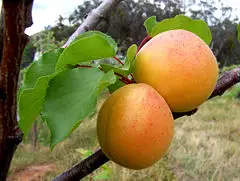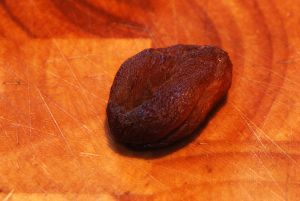Apricot
- For other uses, see Apricot (disambiguation).
| Apricot | ||||||||||||||||
|---|---|---|---|---|---|---|---|---|---|---|---|---|---|---|---|---|
 Apricot fruits
| ||||||||||||||||
| Scientific classification | ||||||||||||||||
| ||||||||||||||||
| Prunus armeniaca L. |
| Apricots, raw Nutritional value per 100 g | ||||||||||||||
|---|---|---|---|---|---|---|---|---|---|---|---|---|---|---|
| Energy 50 kcal 200 kJ | ||||||||||||||
| ||||||||||||||
| Percentages are relative to US recommendations for adults. Source: USDA Nutrient database | ||||||||||||||
| Apricots, dried Nutritional value per 100 g | ||||||||||||||
|---|---|---|---|---|---|---|---|---|---|---|---|---|---|---|
| Energy 240 kcal 1010 kJ | ||||||||||||||
| ||||||||||||||
| Percentages are relative to US recommendations for adults. Source: USDA Nutrient database | ||||||||||||||
The apricot (Prunus armeniaca or Armenian plum in Latin, syn. Armeniaca vulgaris, Armenian: Ծիրան, Chinese: 杏子, Czech: Meruňka) is a fruit-bearing tree, native to Armenia and China and spread to Europe and the Caucasus. [1] It is classified with the plum in the subgenus Prunus of the Prunus genus.
It is a small- to medium-sized tree with a dense, spreading canopy 8–12 m tall; its leaves are shaped somewhat like a heart, with pointed tips, and about 8 cm long and 3–4 cm wide. Its flowers are white to pinkish in color. The fruit appears similar to a peach or nectarine, with a color ranging from yellow to orange and sometimes a red cast; its surface is smooth and nearly hairless. Apricots are stone fruit (drupes), so called because the lone seed is often called a "stone".
The name derives from "apricock" and "abrecox", through the French abricot, from the Spanish albaricoque, which was an adaptation of the Arabic al-burquk, itself a rendering of the late Greek πρεκοκκια or πραικοκιον, adapted from the Latin praecox or praecoquus, early, possibly referring to the fruit maturing much earlier in the summer than plums. However, in Argentina and Chile the word for "apricot" is "damasco" which probably indicates that to the Spanish settlers of Argentina the fruit was associated with Damascus in Syria.
Cultivation

The apricot is thought to have originated in northeastern China near the Russian border. In Armenia it was known from ancient times, and is native to Armenia.[2][3] The Roman General Lucullus (106-57 B.C.E.) even exported some trees,- cherry, white heart cherry and apricot from Armenia to Europe. While English settlers brought the apricot to the English colonies in the New World, most of modern American production of apricots comes from the seedlings carried to the west coast by Spanish missionaries. Almost all U.S. production is in California, with some in Washington and Utah.[4]. Turkey is one of the leading dried-apricot producers.[5] In Armenia apricot is grown in Ararat Valley.
Although often thought of as a "subtropical" fruit, the Apricot is in fact native to a region with cold winters. The tree is slightly more cold-hardy than the peach, tolerating winter temperatures as cold as −30 °C or lower if healthy. The limiting factor in apricot culture is spring frosts: They tend to flower very early, around the time of the vernal equinox even in northern locations like the Great Lakes region, meaning spring frost often kills the flowers. The trees do need some winter cold (even if minimal) to bear and grow properly and do well in Mediterranean climate locations since spring frosts are less severe here but there is some cool winter weather to allow a proper dormancy. The dry climate of these areas is best for good fruit production. Hybridisation with the closely related Prunus sibirica (Siberian Apricot; hardy to −50°C but with less palatable fruit) offers options for breeding more cold-tolerant plants.[6]
Apricot cultivars are most often grafted on plum or peach rootstocks. A cutting of an existing apricot plant provides the fruit characteristics such as flavor, size, etc., but the rootstock provides the growth characteristics of the plant.

Many apricots are also cultivated in Australia, particularly South Australia where they are commonly grown in the region known as the Riverland and in a small town called Mypolonga in the Lower Murray region of the state. In states other than South Australia apricots are still grown, particularly in Tasmania and western Victoria and southwest New South Wales, but they are less common than in South Australia.
Apricots are also cultivated in Egypt and are among the common fruits well known there. The season in which apricot is present in the market in Egypt is very short. There is even an Egyptian proverb that says "Fel meshmesh" (English "in the apricot") which is used to refer to something that will not happen because the apricot disappears from the market in Egypt so shortly after it has appeared. Egyptians usually dry apricot and sweeten it then use it to make a drink called "amar el deen".
Kernels
Seeds or kernels of the apricot grown in central Asia and around the Mediterranean are so sweet that they may be substituted for almonds. The Italian liqueur Amaretto and amaretti biscotti are flavoured with extract of apricot kernels rather than almonds. Oil pressed from these cultivars has been used as cooking oil.
Production trends
| Top Ten Apricot Producers — 2005 (1000 tonnes) | |
|---|---|
| 390 | |
| 285 | |
| 232 | |
| 220 | |
| 181 | |
| 145 | |
| 136 | |
| 123 | |
| Morocco | 103 |
| 101 | |
| World Total | 1916 |
| Source: UN Food & Agriculture Organisation (FAO)[1] | |
Medicinal and non-food uses
Cyanogenic glycosides (found in most stone fruit seeds, bark, and leaves) are found in high concentration in apricot seeds. Laetrile, a purported alternative treatment for cancer, is extracted from apricot seeds. As early as the year 502, apricot seeds were used to treat tumors, and in the 17th century apricot oil was used in England against tumors and ulcers. However, in 1980 the National Cancer Institute in the USA claimed laetrile to be an ineffective cancer treatment.[7]
In Europe, apricots were long considered an aphrodisiac, and were used in this context in William Shakespeare's A Midsummer Night's Dream, and as an inducer of childbirth labor, as depicted in John Webster's The Duchess of Malfi.
The IUD (intrauterine device) form of birth control, based on the premise that a foreign object within the uterus will prevent the implantation of an embryo, is linked to an old practice of camel herders and drivers who would place an apricot pit within the uterus of their female camels to prevent pregenancy and keep them working at carrying cargo rather than the work of mothering.[citation needed]
Dried apricots can also be used as a potent laxative.[citation needed]
Trivia
The Chinese associate the apricot with education and medicine. Chuang Tzu, a Chinese philosopher in 4th century B.C.E., had told a story that Confucius taught his students in a forum among the wood of apricot.[citation needed]
In the 2nd century, Tung Fung, a medical doctor, lived in Lushan. He asked his cured patients to plant apricots in his backyard instead of paying consultation and medical fees. Those cured of serious illness planted five, and the rest planted one. After some years, a hundred thousand apricot trees were planted and the wood become the symbol for doctors and medicine.[citation needed]
In The Wizard of Oz, the Cowardly Lion sings, "What puts the ape in the apricot? Courage!"
Among tank-driving soldiers, apricots are taboo, by superstition. Tankers will not eat apricots, allow apricots onto their vehicles, and often will not even say the word "apricot". This superstition stems from Sherman tank breakdowns purportedly happening in the presence of cans of apricots.[8]
Dreaming of apricots, in English folklore, is said to be good luck, though the Chinese believe the fruit is a symbol of cowardice..[citation needed]
The Turkish idiom "bundan iyisi Şam'da kayısı" (literally, the only thing better than this is apricot in Damascus) means "it doesn't get any better than this" and used when something is the very best it can be; like a delicious apricot from Damascus.
The Church of Jesus Christ of Latter-Day Saints includes in their Children's Songbook the song "Popcorn Popping on the Apricot Tree" describing an apricot tree in bloom. This song, like several others, requires a familiarity with the environment of northern Utah, where the church is based.
Notes
- ↑ Arboretum Et Fruticetum Britannicum: Or, The Trees and Shrubs of Britain, Native and Foreign - Page 682 by John Claudius Loudon
- ↑ CultureGrams 2002 - Page 11 by CultureGrams
- ↑ VII Symposium on Apricot Culture and Decline
- ↑ [http://www.agmrc.org/agmrc/commodity/fruits/apricots/ Agricultural Marketing Resource Center
- ↑ The tendencies of Apricot producers
- ↑ Prunus sibirica - L.
- ↑ http://www.tricountyfarm.org/oregon_apricots.asp
- ↑ Marines Magazine - Marine Corps superstitions
See also
Template:En:wiktionary
- List of apricot diseases
- Apricot kernel
- Pluot
- Ume
- Amygdalin
External links
- Bitter Apricot Seed — information on medicinal uses of apricot seeds
- The Mirror of Literature, Amusement, and Instruction at Project Gutenberg
- About Malatya's Apricot — Natural panacea of worldwıde renown : The Malatya Aprıcot / The Capıtal Of Aprıcot Malatya
Credits
New World Encyclopedia writers and editors rewrote and completed the Wikipedia article in accordance with New World Encyclopedia standards. This article abides by terms of the Creative Commons CC-by-sa 3.0 License (CC-by-sa), which may be used and disseminated with proper attribution. Credit is due under the terms of this license that can reference both the New World Encyclopedia contributors and the selfless volunteer contributors of the Wikimedia Foundation. To cite this article click here for a list of acceptable citing formats.The history of earlier contributions by wikipedians is accessible to researchers here:
The history of this article since it was imported to New World Encyclopedia:
Note: Some restrictions may apply to use of individual images which are separately licensed.

